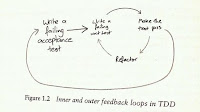 According to Chapter eight (“Defensive Programming”) of Code
Complete, it talks how we can protect our program and how we can avoid error. It
talks about the ways to make defensive program, such as Assertions, Exception, and
Debugging. I think that the most important thing of Defensive programming is
debugging because debugging is essential part of programming. I think that
programming is rare to complete and run perfectly at once. It means that writing
code perfectly is almost impossible. It usually has some errors because of lack
of code. Of course, debugging is not only needed to complete writing code good
to learn how we got wrong and to fix it. The reason why it is also good to
learn is based on process of debugging.
According to Chapter eight (“Defensive Programming”) of Code
Complete, it talks how we can protect our program and how we can avoid error. It
talks about the ways to make defensive program, such as Assertions, Exception, and
Debugging. I think that the most important thing of Defensive programming is
debugging because debugging is essential part of programming. I think that
programming is rare to complete and run perfectly at once. It means that writing
code perfectly is almost impossible. It usually has some errors because of lack
of code. Of course, debugging is not only needed to complete writing code good
to learn how we got wrong and to fix it. The reason why it is also good to
learn is based on process of debugging.What is process of it?
- Check the bug exists or not.
- Check where bug is in program.
- Check why error occurred.
- Make sure of way to fix it/ concern about correct way to run program.
- Fix and test it.
The purpose of this
step to identify or find sigh of bug and knowing a situation that error occurred
and knowing the way to avoid error.
2, Check where is bug in program:
In this step, we need to find and identify which program
cause error.
3, Check why error occurred:
After we find a bug, we will need to know how error
occurred. For example, the situation is program stops because of failure of
data field. In this case, finding error of data field is purpose of this step.
4, Make sure of way to fix it/ concern about correct way to
run program:
After we know the reason that program stops, we need to
think about how to fix it. In this step, we need to know detailed information
of what program is made for because some solution could change its purpose even
if error is fixed.
5, Fix and test it:
After we find correct way to fix the bug, we need to test it
and make sure that the way we try to fix deal with the bug or not and it cause
undesirable side effect or not.
Thus, each step is important to complete code and fix program. In addition, those steps can tell us what, where, and how we got wrong. If we learn how we got wrong and fix it. We can avoid similar error next time.











